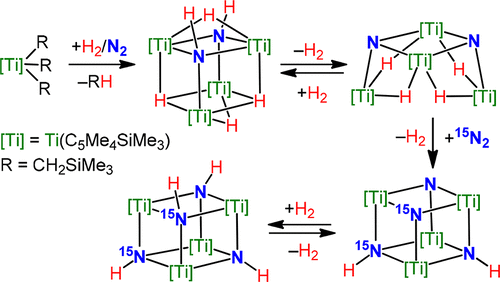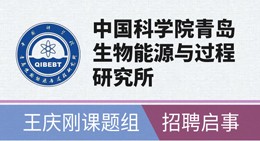当前位置:
X-MOL 学术
›
J. Am. Chem. Soc.
›
论文详情
Our official English website, www.x-mol.net, welcomes your
feedback! (Note: you will need to create a separate account there.)
Experimental and Computational Studies of Dinitrogen Activation and Hydrogenation at a Tetranuclear Titanium Imide/Hydride Framework
Journal of the American Chemical Society ( IF 14.4 ) Pub Date : 2019-01-23 , DOI: 10.1021/jacs.8b13341
Takanori Shima 1, 2 , Gen Luo 1, 3 , Shaowei Hu 1 , Yi Luo 3 , Zhaomin Hou 1, 2, 3
Journal of the American Chemical Society ( IF 14.4 ) Pub Date : 2019-01-23 , DOI: 10.1021/jacs.8b13341
Takanori Shima 1, 2 , Gen Luo 1, 3 , Shaowei Hu 1 , Yi Luo 3 , Zhaomin Hou 1, 2, 3
Affiliation

|
The activation of N2 by a tetranuclear titanium(III) diimide/tetrahydride complex, [(Cp'Ti)4(μ3-NH)2(μ-H)4] (1) (Cp' = C5Me4SiMe3), which was obtained by the reaction of the Cp'-ligated titanium trialkyl complex Cp'Ti(CH2SiMe3)3 with H2 and N2, was investigated in detail by experimental and density functional theory studies. The reaction of 1 in the solid state with N2 (1 atm) at 180 °C gave the dinitride/diimide complex [(Cp'Ti)4(μ3-N)2(μ3-NH)2] (2) through the incorporation, cleavage, and partial hydrogenation of one molecule of N2 and release of two molecules of H2. At 130 °C, the formation of 2 was not observed, but instead, dehydrogenation of 1 took place through cleavage of the N-H bond in an imide ligand, followed by deprotonation of the other imide ligand with a hydride ligand, affording the dinitride/tetrahydride complex [(Cp'Ti)4(μ3-N)2(μ-H)4] (3). Upon heating under N2 (1 atm) at 180 °C, 3 was quantitatively converted to the dinitride/diimide complex 2. This transformation was initiated by migration of a hydride ligand to a nitride ligand to give one imide unit, followed by N2 coordination to a Ti atom and H2 release through the reductive elimination of two hydride ligands. The other imide ligand in 2 was formed by hydride migration to one of the two nitride ligands generated through the cleavage of the newly incorporated N2 unit. The hydrogenation of 2 with H2 (100 atm) at 180 °C afforded the tetraimide complex [(Cp'Ti)4(μ3-NH)4] (4). This reaction was initiated by σ-bond metathesis between H2 and a titanium-nitride bond, followed by migration of the resulting hydride ligand to the remaining nitride ligand. In all of these transformations, the interplay among the hydride, imide, and nitride ligands, including the reversible dehydrogenation/hydrogenation of imide and nitride species, at the multimetallic titanium framework has a critically important role.
中文翻译:

四核钛酰亚胺/氢化物框架下二氮活化和氢化的实验和计算研究
N2 被四核钛 (III) 二亚胺/四氢化物络合物活化,[(Cp'Ti)4(μ3-NH)2(μ-H)4] (1) (Cp' = C5Me4SiMe3),由下式获得通过实验和密度泛函理论研究详细研究了 Cp'-连接的钛三烷基配合物 Cp'Ti(CH2SiMe3)3 与 H2 和 N2 的反应。在 180 °C 下,固态 1 与 N2 (1 atm) 反应得到二氮化物/二亚胺配合物 [(Cp'Ti)4(μ3-N)2(μ3-NH)2] (2) 通过掺入、裂解和部分氢化一分子 N2 并释放两分子 H2。在 130 °C 时,没有观察到 2 的形成,而是通过在一个酰亚胺配体中的 NH 键断裂来发生 1 的脱氢,然后用氢化物配体对另一个酰亚胺配体进行去质子化,得到二氮化物/四氢化物复合物 [(Cp'Ti)4(μ3-N)2(μ-H)4] (3)。在 N2 (1 atm) 下在 180 °C 下加热后,3 被定量转化为二氮化物/二亚胺配合物 2。该转化由氢化物配体迁移至氮化物配体以产生一个酰亚胺单元而引发,随后 N2 配位为Ti 原子和 H2 通过两个氢化物配体的还原消除而释放。2 中的另一个酰亚胺配体是通过氢化物迁移到两个氮化物配体之一而形成的,这些氮化物配体是通过新加入的 N2 单元的裂解产生的。在 180 °C 下用 H2 (100 atm) 氢化 2 得到四酰亚胺配合物 [(Cp'Ti)4(μ3-NH)4] (4)。该反应由 H2 和钛 - 氮化物键之间的 σ 键复分解引发,随后生成的氢化物配体迁移到剩余的氮化物配体。
更新日期:2019-01-23
中文翻译:

四核钛酰亚胺/氢化物框架下二氮活化和氢化的实验和计算研究
N2 被四核钛 (III) 二亚胺/四氢化物络合物活化,[(Cp'Ti)4(μ3-NH)2(μ-H)4] (1) (Cp' = C5Me4SiMe3),由下式获得通过实验和密度泛函理论研究详细研究了 Cp'-连接的钛三烷基配合物 Cp'Ti(CH2SiMe3)3 与 H2 和 N2 的反应。在 180 °C 下,固态 1 与 N2 (1 atm) 反应得到二氮化物/二亚胺配合物 [(Cp'Ti)4(μ3-N)2(μ3-NH)2] (2) 通过掺入、裂解和部分氢化一分子 N2 并释放两分子 H2。在 130 °C 时,没有观察到 2 的形成,而是通过在一个酰亚胺配体中的 NH 键断裂来发生 1 的脱氢,然后用氢化物配体对另一个酰亚胺配体进行去质子化,得到二氮化物/四氢化物复合物 [(Cp'Ti)4(μ3-N)2(μ-H)4] (3)。在 N2 (1 atm) 下在 180 °C 下加热后,3 被定量转化为二氮化物/二亚胺配合物 2。该转化由氢化物配体迁移至氮化物配体以产生一个酰亚胺单元而引发,随后 N2 配位为Ti 原子和 H2 通过两个氢化物配体的还原消除而释放。2 中的另一个酰亚胺配体是通过氢化物迁移到两个氮化物配体之一而形成的,这些氮化物配体是通过新加入的 N2 单元的裂解产生的。在 180 °C 下用 H2 (100 atm) 氢化 2 得到四酰亚胺配合物 [(Cp'Ti)4(μ3-NH)4] (4)。该反应由 H2 和钛 - 氮化物键之间的 σ 键复分解引发,随后生成的氢化物配体迁移到剩余的氮化物配体。

































 京公网安备 11010802027423号
京公网安备 11010802027423号